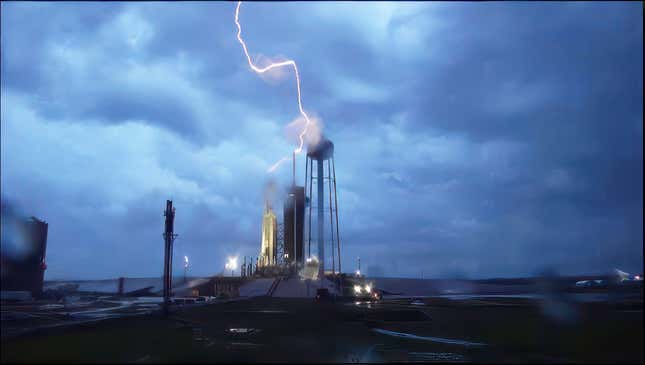SpaceX’s large Falcon Heavy rocket is on a mission to instantly ship three satellites to excessive Earth orbit, which implies the corporate received’t have the ability to recuperate any of the three boosters. You’ll be able to watch the launch reside proper right here.
Replace: 7:00 p.m. ET: SpaceX is now targeting 8:26 p.m. ET for launch, saying climate is now 70% favorable.
Unique article follows.
The Falcon Heavy rocket is scheduled to blast off on Friday, April 28, from Launch Complicated 39A at NASA’s Kennedy House Middle in Florida, with the 57-minute launch window opening at 7:29 p.m. ET. You’ll be able to watch the launch reside on SpaceX’s website or by way of its reside feed, accessible beneath, which can start quarter-hour previous to liftoff. House Power’s forty fifth Climate Squadron says there’s a couple of 30% probability of favorable circumstances for the night launch, which isn’t nice.
SpaceX had hoped to launch the rocket yesterday, however a storm blew by way of, producing hail, tornadoes, and lightning. A lightning bolt even struck the tower at Complicated 39A, requiring SpaceX’s floor groups to carry out further checkouts of the rocket, its payloads, and floor tools, in line with an organization tweet.

The Falcon Heavy rocket stands 230 toes tall (70 meters) and consists of three reusable Falcon 9 first levels strapped collectively. It has two reusable facet boosters, a reusable heart core, an expendable second stage, and a pair of reusable fairing halves. The heavy-lift automobile is about to carry out its sixth mission, having debuted in 2018.
Whereas Falcon Heavy is extra highly effective than SpaceX’s workhorse Falcon 9 rocket, it could quickly be overshadowed by the Starship rocket, which made its first test flight on April 20 however needed to be destroyed after it entered a deadly tumble.
The rocket shall be carrying three satellites, together with the first payload, the broadband ViaSat-3 Americas satellite tv for pc, which weighs 14,000 kilos (6,400 kilograms) and shall be delivered to a geostationary orbit. The opposite two satellites, Astranis’s first MicroGEO satellite tv for pc and Gravity House’s GS-1 satellite tv for pc, are additionally headed for geostationary orbit.
For the reason that major payload shall be positioned instantly in its distant orbit, the Falcon Heavy boosters must be discarded—they’ll fall into the Atlantic Ocean. Usually, the boosters carry out vertical landings, however this job, with that additional push to geostationary orbit, would require them to expel their gasoline, making a touchdown unattainable. This would be the first time that SpaceX deliberately disposes of all three Falcon Heavy boosters, according to SpaceflightNow.
Geostationary orbit, or GEO for brief, is greater than 20,000 miles (almost 36,000 kilometers) above Earth, which is about one-tenth the space to the Moon. Many communication and climate satellites work in GEO as a result of it permits them to stay in a set place relative to the Earth’s floor.
Wish to know extra about Elon Musk’s area enterprise? Try our full protection of SpaceX’s Starship megarocket and the SpaceX Starlink internet satellite megaconstellation. And for extra spaceflight in your life, comply with us on Twitter and bookmark Gizmodo’s devoted Spaceflight page.
Trending Merchandise

Cooler Master MasterBox Q300L Micro-ATX Tower with Magnetic Design Dust Filter, Transparent Acrylic Side Panel…

ASUS TUF Gaming GT301 ZAKU II Edition ATX mid-Tower Compact case with Tempered Glass Side Panel, Honeycomb Front Panel…

ASUS TUF Gaming GT501 Mid-Tower Computer Case for up to EATX Motherboards with USB 3.0 Front Panel Cases GT501/GRY/WITH…

be quiet! Pure Base 500DX Black, Mid Tower ATX case, ARGB, 3 pre-installed Pure Wings 2, BGW37, tempered glass window

ASUS ROG Strix Helios GX601 White Edition RGB Mid-Tower Computer Case for ATX/EATX Motherboards with tempered glass…










